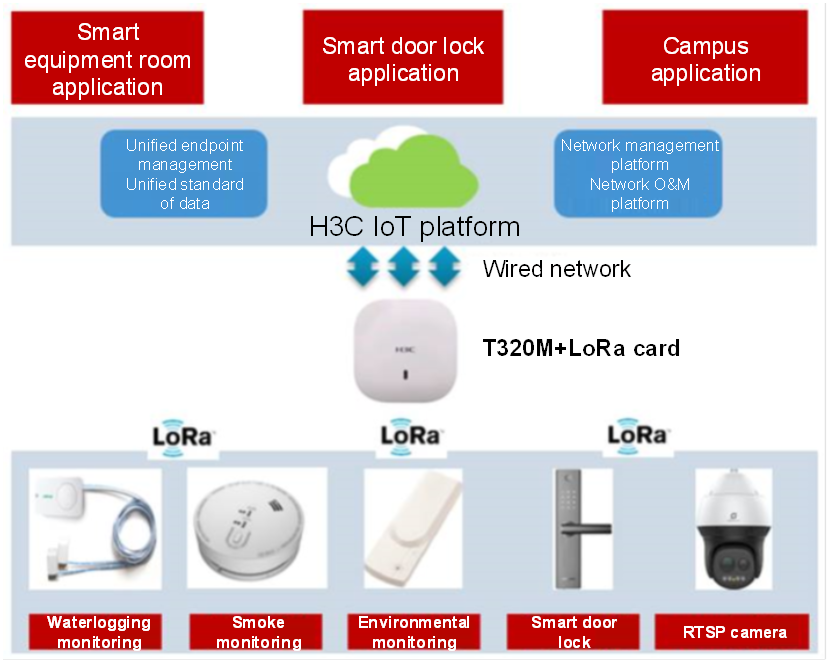Country / Region
Smart ELV Room Solution
Requirement analysis
The central equipment room is an important part of the information system. Information management personnel attach great importance to the physical security of the central equipment room. In addition to the central equipment room, extra-low voltage room (ELV room) is also a very important scenario. As the transfer station for transmitting information of the central equipment room, ELV room is an important place to support the normal operation of the information system.
Generally, the equipment room that provides various smart control systems for the building is referred to as ELV room. Services involved include but are not limited to network communication, fire control, broadcast system, and building control.
At present, the common management issues of ELV room are as follows:
1. Inefficient manual patrol
The ELV rooms are distributed in all corners of the campus. The traditional manual patrol is time-consuming and laborious. Unless specially required, large-scale detailed inspection is not usually carried out.
Most of the time, the ELV room is unattended, so it is difficult to detect any abnormality in time. Usually after a reverse event occurs, there is no choice but to inspect the ELV room for repair.
2. Disordered management of ELV room
The responsibility department of the ELV room property is unclear. From the perspective of informatization, the information department should be responsible for the management of ELV rooms. From the perspective of security, the security department must control the security of ELV rooms.
Without the smart door lock system, the abnormality of the unattended ELV rooms cannot be found in time. Poor key management of ELV rooms makes the door lock security level low, causing potential hazards of illegal invasion.
3. Potential environmental hazards in ELV room
Many devices such as switches and operator gain hosts are usually placed in the ELV room. In the ELV room, there are many devices in narrow space with no cooling facility in general. Some ELV rooms are packed with sundries. As a result, the devices may not work normally, or even burn out or catch fire due to high temperature.
Some ELV rooms are close to the bathroom or the doors and windows are not sealed enough. The water seepage and leakage may directly affect the operation of devices in the ELV room.
In case of any above-mentioned potential environmental hazard (abnormal temperature and humidity, fire, and water leakage) in ELV rooms, the fault cannot be alarmed or handled timely.
Overall solution

The overall architecture of smart ELV room solution meets the standard of the following four-layer IoT models:
Terminal layer: Includes environment monitoring sensor (temperature and humidity) and fire monitoring sensor (flood and smoke). The camera is connected through a cable, and the rest are connected through LoRaWAN.
Network layer: One T320M+LoRa card is deployed in each ELV room to provide the LoRa access capability for terminal-layer devices. By default, the T320M also supports the access of the RFID or BLE. The T320M can reserve the extended personnel positioning and asset positioning functions, such as monitoring whether important devices in the equipment room are removed from the room.
Platform layer: As a dedicated PaaS platform for the IoT solution, the IoT platform supports applications, adapts to terminals, and realizes horizontal capability integration.
Application layer: Multiple application systems are built in the platform, including the ELV room application, smart door lock application, campus integrated management system, and asset positioning system. Interfaces can also be provided to support third-party applications.
Solution capabilities
1) Monitoring ELV rooms
Support the hierarchical management of ELV rooms to monitor the temperature and humidity, water leakage, smoke, door lock, and video information of each ELV room in real time.
Deploy temperature and humidity sensors at important locations in the ELV room, and collect and report temperature and humidity to the IoT platform in real time. Once the temperature and humidity exceed the specified limits, the management personnel should be reminded to adjust the device distribution and operation status in the equipment room in time. In addition, the IoT platform stores the reported temperature and humidity data and provides the temperature and humidity change curve to management for reference. The management personnel can adjust the temperature and humidity according to the local season.
Deploy a smoke alarm in the ELV room to monitor the ambient air in real time. When a fire occurs in the ELV room, an alarm is triggered and reported to the IoT platform. The IoT platform immediately reminds management personnel to handle it in time based on the configuration.
At the same time, the alarm will activate the built-in speaker to issue a "fire" voice message, providing more time for people to evacuate before the fire spreads.
The devices in ELV rooms are extremely sensitive to water. Once a water leakage accident occurs, device damage and information loss may occur. Failure to detect or locate leaks in time may result in great losses. Water leakage hazards in ELV rooms are probably from ceiling/window, air conditioner and water supply pipes.
Water leakage induction lines are laid under or around the above leak-prone areas in the equipment room. When the water leakage induction line detects water, an alarm is triggered and reported to the IoT platform. The IoT platform immediately reminds management personnel to handle it in time based on the configuration.
The IoT platform supports direct access to the camera of the RTSP protocol, and can directly play the real-time video stream of the specified camera.
If the camera has an independent VMS, the platform supports indirect management of the camera through the interconnection of intersystem interfaces, such as reading the real-time stream URL of the camera and operating on the cloud platform. This function needs to be customized according to the actual conditions.
2) Alarm of ELV rooms
Alarms can be flexibly configured for ELV rooms and management personnel can be arranged based on the device or zone. After the alarm is triggered, the management personnel can be notified through voice, short message and email.
The platform summary alarm provides relevant statistics and analysis functions, such as alarm ranking in the ELV room and distribution of different types of alarms, to facilitate the management personnel's visualization and decision-making.
Based on the alarm statistics and analysis, the management personnel can screen out key ELV rooms (with a large number of alarms), alarm types, and time periods (such as weekends). This result can facilitate the task arrangement of the management personnel and provide data support for accurate decisions.
3) Door lock management in ELV rooms
The smart door lock management application based on IoT platform can remotely and uniformly manage the smart door lock online, and authorize users online to unlock the door through swiping card, password or a fingerprint.
Issuance of door lock permissions: The permissions of each door lock can be issued uniformly through the smart door lock management application. For different ELV rooms, the list of door lock management personnel, grouped authorization, and the door opening permission can be configured respectively.
Fingerprint input: The batch input of fingerprints consumes a great deal of time and energy. In this solution, the management personnel of ELV rooms can input fingerprints independently through WeChat mini program. The system administrator can authorize the number and valid time of input fingerprints, and delete the fingerprint in batches.
Remote unlock: If the management personnel of ELV rooms forget the key or need to unlock the door of the equipment room in daily operation, they can unlock the door remotely through the management application (supporting batch remote unlock).
Patrol and inquiry: During routine management of patrol tasks in ELV rooms, the unlock conditions in the patrol can be monitored according to door lock log reports of the management application, including the unlock time, unlock person, and unlock mode of the door.
Benefits
H3C smart ELV room solution enhances the security control and management capabilities of ELV rooms, and effectively clarifies the rights and responsibilities of each service department, achieving informatization results at minimal costs.
Increased productivity
The management efficiency is improved by responding to various emergency alarms in real time through automatic and smart management of ELV rooms. The manpower used in the traditional patrol of ELV rooms is completely saved, to avoid the evasion of responsibilities of each service department. In addition, statistical analysis and visualization of monitoring data provide data support and auxiliary decision for management.
Improved security control
The real-time control of potential environmental hazards (temperature, humidity, smoke, and water leakage) in the ELV room is realized. In case of any abnormality, the alarm will be sent to the management personnel timely for handling.
The access security is improved through the B+ level smart door lock (non-electromagnetic lock). At the same time, the unlock history of the ELV room is recorded for tracing.
Low deployment cost
Most of the existing smart equipment room systems in the market use wired networks to transmit data. The large number and scattered distribution of sensing components in the equipment room make the integrated cabling in the equipment room complex and costly.
This solution requires no cabling through LoRa wireless technology, realizing rapid deployment. The integrated cabling and decoration costs as well as the O&M costs of cables are all saved.
Strong scalability
Scalability of the IoT gateway: The solution supports the access of LoRaWAN terminal and the RFID/BLE terminal. The solution also supports the access of protocol terminals such as ZIGBEE and UWB by using a series module.
Scalability of the IoT platform: The platform supports the foregoing multi-protocol access and universal LoRaWAN protocol, laying a foundation for subsequent IoT expansion on campus. The platform also supports applications such as asset management and campus integration, flexible access to devices, and interconnection between systems.


